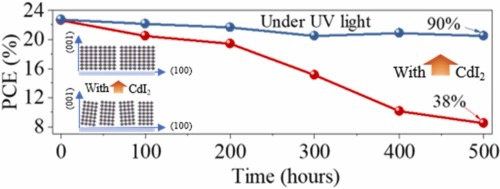Suppressing the crystallographic disorders induced by excess PbI2 to achieve trade-off between efficiency and stability for PbI2-rich perovskite solar cells

Excess PbI2 can improve the efficiency of perovskite solar cells (PSCs). However, it usually leads to poor cell stability due to the chemically active nature of PbI2. Improving the stability of PbI2-rich perovskite solar cells without scarifying the efficiency remains challenging. In this work, it is found that the non-uniform and multiple nucleation of perovskite induces crystallographic disorders at grain boundaries (GBs) of PbI2-rich perovskite. These disorders working as the n-type shallow dopant reduces the energy barrier for photogenerated electrons to reach GBs, triggering the decomposition of excess PbI2 there. Therefore, the instability of PbI2-rich PSCs is related with the remote coupling of excess PbI2 with the disorders at GBs. In light of this finding, we introduced a small amount (0.5 mol%) of CdI2 into precursor solution to optimize the crystallization of PbI2-rich perovskite, and finally achieved a trade-off between efficiency and stability in PbI2-rich PSCs. The optimized PSCs with 10 mol% excess PbI2 (PC-Device) achieved a champion efficiency of 24.26% at the bandgap 1.55 eV with robust stability. PC-Devices maintain more than 90% of the initial efficiency after being stressed under UV light in ambient with a relative humidity of 50% for 500 hours, and 70% under heat at 85˚C for 400 hours, both of which are far superior to the pristine PbI2-rich solar cells.
Publisher URL: https://www.sciencedirect.com/science/article/pii/S2211285522010928
DOI: 10.1016/j.nanoen.2022.108014
Keeping up-to-date with research can feel impossible, with papers being published faster than you'll ever be able to read them. That's where Researcher comes in: we're simplifying discovery and making important discussions happen. With over 19,000 sources, including peer-reviewed journals, preprints, blogs, universities, podcasts and Live events across 10 research areas, you'll never miss what's important to you. It's like social media, but better. Oh, and we should mention - it's free.
Researcher displays publicly available abstracts and doesn’t host any full article content. If the content is open access, we will direct clicks from the abstracts to the publisher website and display the PDF copy on our platform. Clicks to view the full text will be directed to the publisher website, where only users with subscriptions or access through their institution are able to view the full article.


